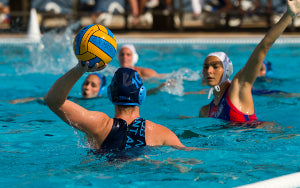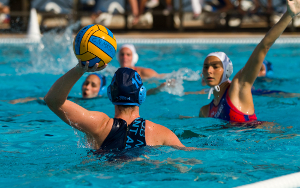Water Polo Six-on-Five Situation
June 17, 2019

 Efficient six-on-five offense skills are one of the most important attributes a team can have. As a primary outlet for goals, a well-run six-on-five offense can often be a deciding factor between two equally-matched teams. Furthermore, man-up or man-down situations are fairly common in water polo games, as it’s been estimated that one third of a water polo game is played in this situation. This guide will explain the offensive and defensive tactics that a team must take for an effective six-on-five situation.
Efficient six-on-five offense skills are one of the most important attributes a team can have. As a primary outlet for goals, a well-run six-on-five offense can often be a deciding factor between two equally-matched teams. Furthermore, man-up or man-down situations are fairly common in water polo games, as it’s been estimated that one third of a water polo game is played in this situation. This guide will explain the offensive and defensive tactics that a team must take for an effective six-on-five situation.
The Formations
The primary offensive formation for a six-on-five situation is referred to as a “Four-Two” offense, because there are four players on the 2m line and two players up top, at about the 5m line. The four front players will line up on the 2m line, two players in-line with the posts, at the two and three positions, and two players roughly at the wing positions, referred to as the one and six positions. The back two players will line up at the four and five positions, which is around the 5m marker and in-line with the posts (just above the two front offensive players). This set-up forces one defender to cover two players.
It is estimated that over 60 percent of six-on-five situations result in a goal.
The one, four, five, and six positions are both passers and shooters. The two and three positions are primarily responsible for shooting and seldom pass the ball. The six position is the primary passer, as this position presents a poor shooting angle, but an advantageous angle for passes (especially if the recipient is right-handed). The one position, although a primary passer, presents a slightly better shooting angle for (right-handed players), so shots can be taken from this position.
The focus of this offense is to move the ball around as much as possible to tire the goalie and catch him off guard while he is on the opposite side or moving across the cage.
Three-Three pattern
Another formation for a six-on-five offense is the three-three, referred to as such because there are three players on the bottom as well as the top. The bottom three offensive players (closest to the goal) will typically experience man-to-man coverage. However, only two defenders are split among three offensive players up top, leaving someone open for a shot at all times.
Despite the bottom three offensive players’ close proximity to the cage, it is the top players are the primary shooters, when unguarded. The key is to pass the ball from player to player across the field until one player receives the ball while the goalie is out of position. This is the best for shooting a successful goal.
Revolving Pattern
 In essence, this is simply the combination of a four-two and a three-three pattern. In a man-up situation, the offensive team begins the ‘power play’ in a typical four-two formation. Then, either the one or six position wraps up with the two and three positions on their respective side. An inverse formation change can also occur in which a three-thee offense can become a four-two. The benefit of revolving the pattern is to disorganize the defense, who is already one player down. A successful revolving offense can easily lead to a close wide-open shot on goal.
In essence, this is simply the combination of a four-two and a three-three pattern. In a man-up situation, the offensive team begins the ‘power play’ in a typical four-two formation. Then, either the one or six position wraps up with the two and three positions on their respective side. An inverse formation change can also occur in which a three-thee offense can become a four-two. The benefit of revolving the pattern is to disorganize the defense, who is already one player down. A successful revolving offense can easily lead to a close wide-open shot on goal.
Six-on-Five Offensive Overview
Regardless of the pattern a team decides to pursue in a six-on-five situation, the most important tactic is to move the ball quickly and efficiently. By doing this, the offensive team disorients and exhausts the goalie and defenders. Setting up an offensive pattern in a timely manner is also essential to a successful man-up situation. As soon as the kick-out occurs, players should quickly move to an open position or assume the position their coach has designated for them. Practice transitioning into this formation from a typical umbrella offense, focusing on fast and efficient shot-faking and passing. Rotate from a four-two to a three-three offense when possible.
Six-on-Five Defensive Overview
The job of a defenseman in a six-on-five situation is to shut-down the offense as best as possible. At times, this will require him to split his efforts among two offensive players, which is not an easy task. The most important goal for the defenders is to never stop moving. When the ball is passed to an offensive player that they are responsible for, they should press him while obstructing any chance of a shot on goal. As soon as the ball is passed to another player, that defenseman is to drop back into zone coverage, helping out his fellow teammates. Being on the defensive end of a six-on-five situation should be exhausting.
Defensive players on the two meter line are responsible for reading plays, shots, and passes. If a defenseman notices the one and three positions are moving up for a quick pass-to-shot, he should call out his read to his fellow teammates and shift his defense accordingly. Offensive players who look like they are about to receive a pass should be pressed. If an offensive player with the ball presents a threat of a shot on goal, the defenseman should move out to a press while using their arms to obstruct his view. Additionally, if the goalie is positioned in the left side of the cage, the defensive player should position himself to obstruct the right side of the cage, narrowing an open shot for the offensive player.
The defensive player nearest his steam’s kick-out zone should be ready to drop his outside defender once his teammate is allowed back into play by the official. Communication is important when the ejected player is allowed back in the game so all other defensemen know to move back to their standard six-on-six coverage, leaving the offensive player nearest the ejection zone open for the newly-admitted player to cover.
Practice and Consistency
As with all water polo plays and tactics, practice makes perfect. Six-on-five situations require practice to accustom the players to the man-up or man-down situation. It’s important to train for efficiency in both circumstances as any team will commonly find themselves on either side during a game. Teams should recreate six-on-five situations during practice to develop their comfort level while executing the plays and techniques mentioned above. Kick-outs are a very common occurrence in water polo games so a team with a strong, efficient six-on-five (offense and defense,) will achieve great success.



